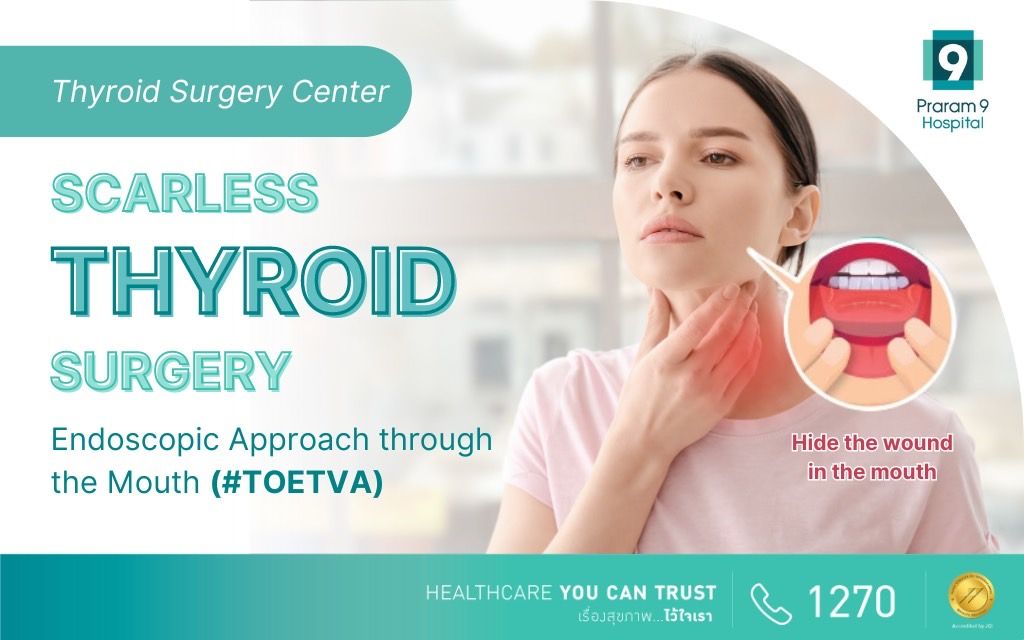Health Articles
Knowledge
Scarless Thyroid Surgery : Endoscopic Approach through the Mouth (#TOETVA)
THANYAWAT SASANAKIETKUL,M.D

Tired of the idea of a neck scar from thyroid surgery? There’s a new, minimally invasive option: Transoral Endoscopic Thyroidectomy (TOETVA). This article explores TOETVA, its benefits, and why it might be the right choice for you.
Table of content
- Who Needs Thyroid Surgery?
- Traditional vs. Endoscopic Thyroid Surgery
- Why Choose Transoral Endoscopic Thyroidectomy (TOETVA)?
- Who is a Candidate for Transoral Endoscopic Thyroidectomy (TOETVA)?
- Benefits of Transoral Endoscopic Thyroidectomy (TOETVA)
- Thyroid Surgery Center at Praram9 Hospital
Who Needs Thyroid Surgery?
There are three main types of thyroid disease:
- Hyperthyroidism: Overactive thyroid function
- Hypothyroidism: Underactive thyroid function
- Thyroid Nodules: Lumps or mass in the thyroid (can be benign or cancerous)
Medication is often the first line of treatment, especially for mild cases or low risk of cancer. However, surgery becomes necessary for:
- Fail Medication
- Severe symptoms such as breathing or swallowing
- Large or fast-growing nodules
- Confirmed thyroid cancer
Traditional vs. Endoscopic Thyroid Surgery
There are two main types of thyroid surgery:
Open Thyroidectomy
Traditional surgery with a neck incision, leaving a visible scar (6-8 cm).
Endoscopic Thyroidectomy
Minimally invasive surgery using an endoscope (camera) through smaller incisions in various locations:
- Armpit
- Breast
- Behind the ear
- Oral Cavity (TOETVA)
Why Choose Transoral Endoscopic Thyroidectomy (TOETVA)?
TOETVA offers several advantages over traditional surgery:
Scarless Neck
Incisions are hidden inside the mouth, leaving no visible scar on the neck.
Faster Recovery
Smaller incisions mean quicker healing and less pain, allowing for a faster return to daily activities.
Reduced Risk of Complications:
High-resolution cameras provide magnified views for surgeons, leading to precise identification of critical structures like the parathyroid glands and vocal cords. This minimizes the risk of nerve damage, post-surgical hoarseness and other complications.
Who is a Candidate for Transoral Endoscopic Thyroidectomy (TOETVA)?
- Fewer side effects compared to traditional surgery
- lower risk of nerve injury, hoarseness, or low calcium levels
- Waterproof wound allows for normal showering
- Considered the latest and safest technique for scarless thyroid surgery
Thyroid Surgery Center at Praram9 Hospital
Praram 9’s Thyroid Surgery Center offers a comprehensive approach to treating thyroid disorders, including diagnosis, screening and surgery by a renowned team of expert clinicians using state-of- the-art medical facilities and equipment.
Dr. Thanyawat Sasanakietkul, a highly experienced specialist surgeon at Praram 9 Hospital in both open and endoscopic oral cavity thyroidectomy at Praram9 Hospital, has performed over 2,000 thyroid surgeries, including both open and endoscopic procedures. With expertise in treating various thyroid conditions, such as hyperthyroidism, goiter, Hashimoto’s thyroiditis, benign thyroid nodules, and thyroid cancer, he is renowned as one of the pioneering surgeons globally to perform endoscopic thyroidectomy via the oral cavity.
As mentioned, endoscopic thyroidectomy through the oral cavity eliminates the need for external skin incisions, reduces postoperative pain, promotes rapid recovery, and minimizes the risk of hoarseness after surgery. Therefore, it is considered an appealing surgical option in the present time.















